

In September 2017, Hurricane Maria devastated Puerto Rico. It was one of the deadliest and most damaging natural disasters to ever make landfall in the United States. Maria destroyed infrastructure and crops and initially claimed 64 lives. The aftermath was even more calamitous: More than 4,000 people are estimated to have died as a result of the shortage of medical care and basic resources during the extended power outages that followed the storm, according to research reported in The New England Journal of Medicine. Low-income and rural communities suffered the most, with some remaining without power for almost a year.
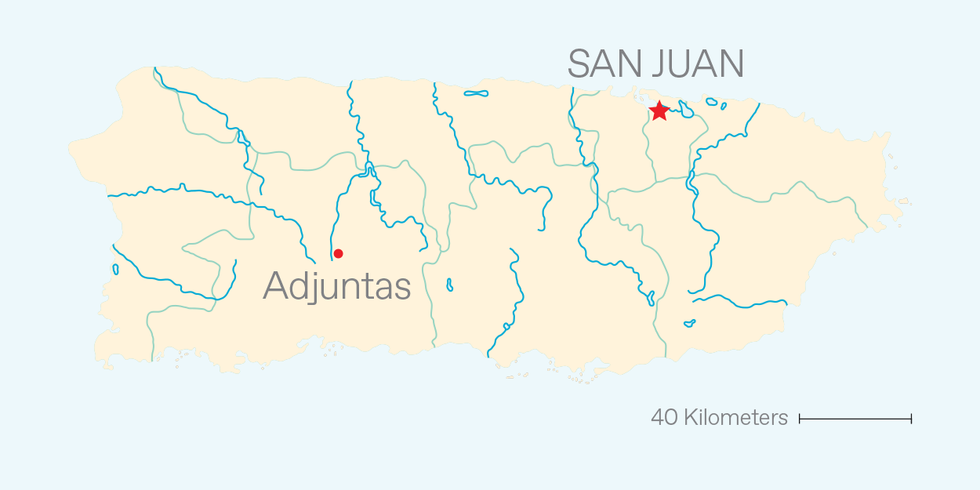
The winds had barely died down when electric-power specialists and others began calling for a radical overhaul of Puerto Rico’s electricity networks, one that would emphasize renewable energy, distributed generation, and, critically, microgrids.
A microgrid is like a miniaturized, tightly controlled version of a power grid. Each microgrid includes generation, loads, transformers, distribution lines, protective devices, and, typically, energy storage. Several factors combine to make Puerto Rico an ideal place for solar power and microgrids. The island gets on average nearly 3,000 hours of sunshine per year, putting it on a par with Honolulu and Brisbane, Australia. And it is vulnerable to precisely the kind of destructive storms that microgrids are designed to ride out with minimal interruption in electric service.
People, Power, and the Sun: Honnold Foundation x Adjuntas, Puerto Rico
Although most microgrids today operate independently, one way to get the maximum benefit from them is to connect them, letting them share resources wherever and whenever possible. To that end, engineers at the U.S. Department of Energy’s Oak Ridge National Laboratory (including three of us—Ferrari, Ollis, and Starke) are investigating distributed controllers that will allow microgrids to form a larger network that will increase their resiliency and facilitate the integration of more renewable energy. Such networked microgrids can be isolated for longer periods from the main grid, which is crucial during long-term outages caused by severe weather and other natural disasters.
We have designed such a controller, which we call a microgrid orchestrator, and are now developing facilities to thoroughly test it in the lab. Next year, we plan to install and further test our controller on-site in the central Puerto Rican community of Adjuntas. Ultimately, such technology could benefit any part of the world where the electricity network is vulnerable to outages and where increasing amounts of solar and wind power are being integrated into the power grid.
How can a microgrid help after a power outage?
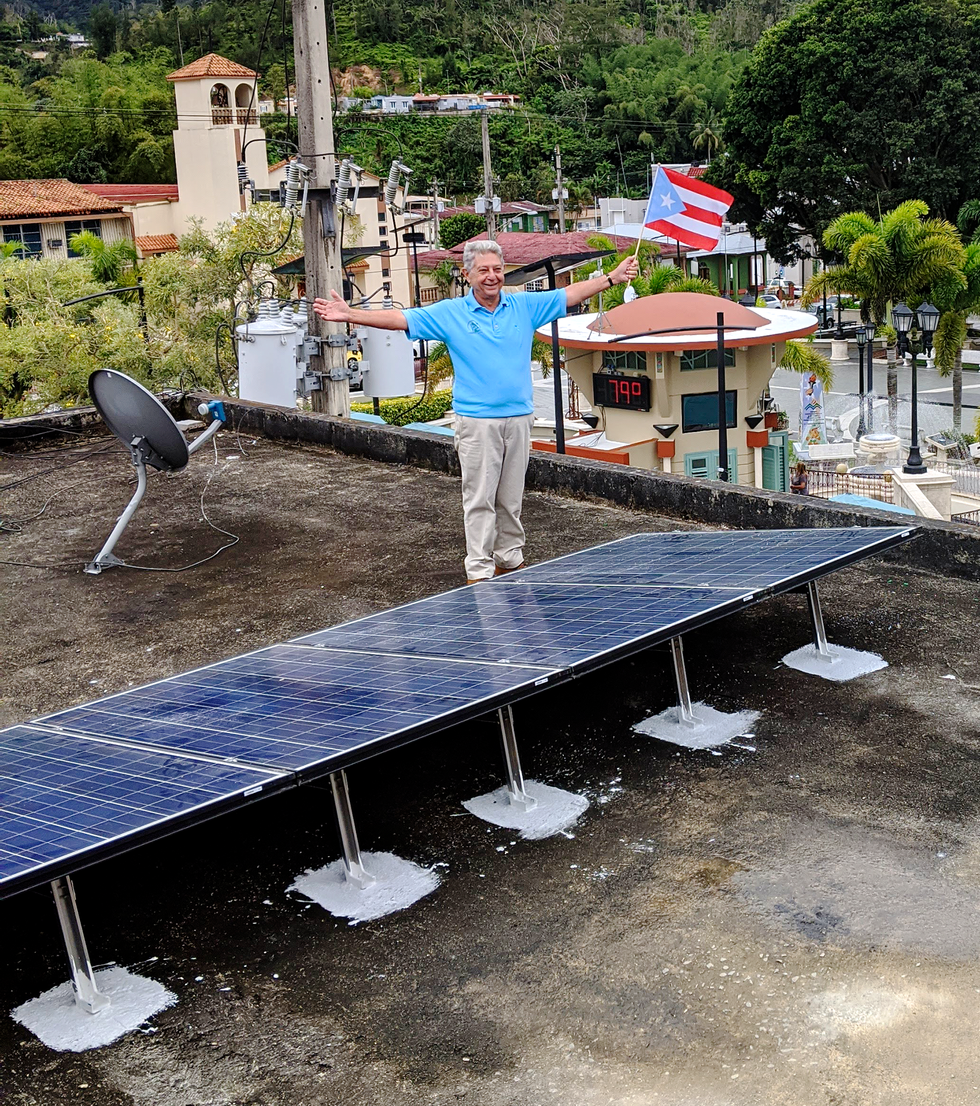 Alexis Massol González, founder of the environmental nonprofit Casa Pueblo de Adjuntas, stands next to a rooftop PV installation, one of more than 400 deployed in the region.The Honnold Foundation
Alexis Massol González, founder of the environmental nonprofit Casa Pueblo de Adjuntas, stands next to a rooftop PV installation, one of more than 400 deployed in the region.The Honnold Foundation
In the darkness caused by Hurricane Maria, a grassroots environmental nonprofit called Casa Pueblo de Adjuntas provided hope for the people of Adjuntas. (Coauthor Massol-Deyá is executive director of the organization.) The group is a pioneer in bringing solar energy to Puerto Rico, having installed the first photovoltaic (PV) panels in Adjuntas in 1999. During and after Maria, Casa Pueblo continued to operate a solar-based microgrid it had installed in 2017. The microgrid provided vital services, including running dialysis machines, refrigerating medicines, and charging cellphones. Adjuntas, a region that shares the same name of its main town, is known for its many coffee plantations and has a population of about 18,000 spread among 16 towns and villages. Casa Pueblo’s solar-powered radio transmitter was the main means of disseminating news across central Puerto Rico after the 2017 storm.
Maria was not an isolated event—since it struck, eight major storms have either hit the island directly or passed close enough to have caused flooding or power losses. So, vulnerable communities in Puerto Rico and elsewhere must decide how they will cope with future disasters, intensified by the effects of a changing climate. The residents of Adjuntas have chosen a path toward self-sufficiency and a power system that is relatively clean, decentralized, and resilient.
The Adjuntas model is built around solar-powered microgrids. A key feature of a microgrid is the option of operating it connected to the main grid—a mode called grid-connected—or isolated from the grid, in islanded mode. Islanding lets microgrids continue to supply electricity to users even when the main grid is down. In 2019, in partnership with the Honnold Foundation and other organizations, Casa Pueblo started connecting the Adjuntas town square to two solar-powered microgrids. Construction was completed this past March, and the microgrids will be fully operational by the end of the year.
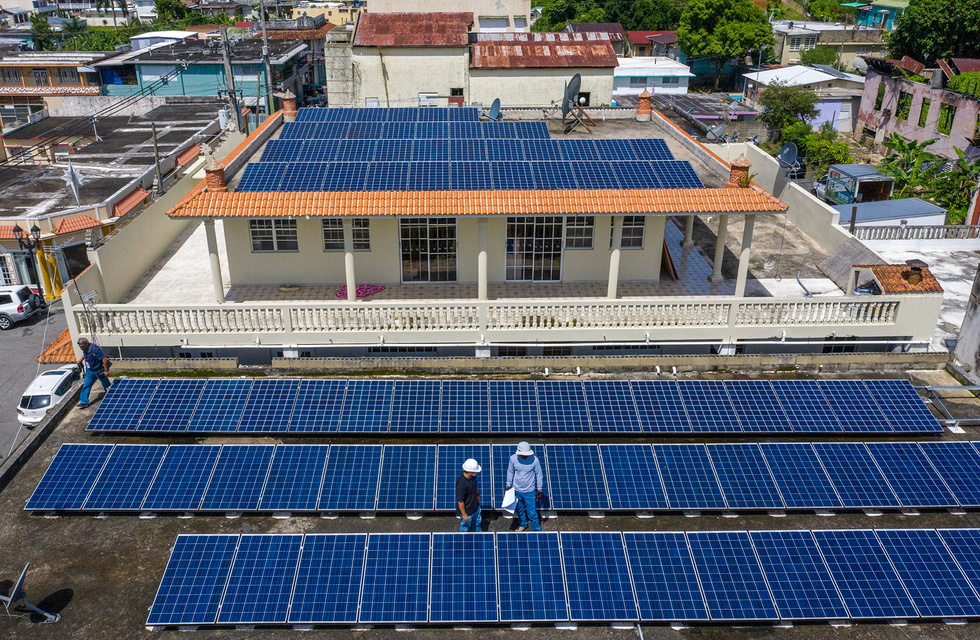 Rooftop solar power totaling about 200 kilowatts, complemented by 1 megawatt-hour of battery storage , supplies electricity to 14 businesses in Adjuntas.Ricardo Arduengo/The Honnold Foundation
Rooftop solar power totaling about 200 kilowatts, complemented by 1 megawatt-hour of battery storage , supplies electricity to 14 businesses in Adjuntas.Ricardo Arduengo/The Honnold Foundation
Puerto Rico’s government has committed to transitioning to 100 percent renewable energy by 2050, with interim goals of 40 percent by 2025, the phaseout of coal-fired plants by 2028, and a 60 percent renewable system by 2040. Meanwhile, though, much of the island continues to rely on a centralized grid that is fed mainly by power plants that burn natural gas, petroleum, or coal. From 2014 to 2022, the Puerto Rican power company, PREPA, increased its share of renewable energy from 1.7 percent to 2.8 percent. During this same period, distributed residential solar connected to the main grid saw an incredible 50-fold increase, from 4.4 megawatts to 224.6 MW. The growth in residential solar capacity has been 2.5 times as great as the combined growth in the commercial and industrial sectors.
Solar-based microgrids have also seen an uptick in adoption since Maria. During prolonged outages, they can provide a cleaner and less expensive alternative to emergency diesel generators. Diesel generators emit harmful pollutants and are expensive to operate, especially in the aftermath of a devastating storm, when fuel is scarce. Following Maria, businesses in Adjuntas struggled to obtain enough diesel and spent thousands of dollars on fuel to keep their generators operating—an expense that sorely tested them.
Sunlight, though, is a free and abundant energy source in Puerto Rico, and solar-based microgrids have proven to be a reliable alternative to the central grid. The two microgrids in Adjuntas encompass more than 700 PV panels installed on the rooftops of 14 small businesses in the center of the town, including the bakery, the pizzeria, and critical facilities such as the pharmacy. The microgrids, which have a total capacity of about 200 kilowatts, as well as two large battery-storage systems with more than 1 megawatt-hour of capacity, are designed to power these businesses.
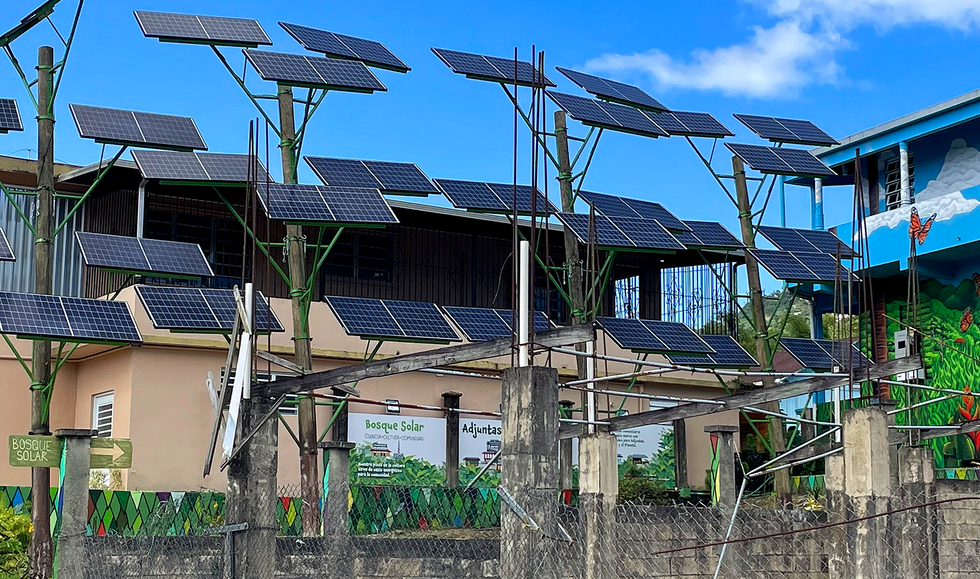 The Solar Forest, a novel installation of PV panels, doubles as a public charging station in the town square of Adjuntas. Heather Duncan/ORNL
The Solar Forest, a novel installation of PV panels, doubles as a public charging station in the town square of Adjuntas. Heather Duncan/ORNL
Most microgrids run in grid-connected mode whenever the main grid is available. The microgrids in Adjuntas, however, are designed to run in islanded mode, disconnected from the main grid. They’re owned, operated, and maintained by a nonprofit cooperative, which functions as an independent system operator. The businesses thus purchase electricity that is generated locally. Each business is equipped with its own energy meter, and at the end of the month it’s charged for the electricity it consumed.
Business owners pay a rate that’s lower than the main grid rate on the island, which is one of the highest in the United States. The average cost of electricity for commercial users in Puerto Rico is about 29 U.S. cents per kilowatt-hour; in May, the rate on the United States mainland was about 13 cents per kilowatt-hour. Revenue generated by the microgrids will be reinvested into the community in several ways, including operation, maintenance, and future expansion of the microgrids, and as an emergency fund to bring solar energy to other low-income communities in the area.
The experience of regularly operating the system in islanded mode will be crucial when the next natural disaster shuts down the main grid. During such extreme events, the connected businesses will serve the entire community by providing refrigeration for medicines and perishables, power to recharge smartphones and laptops, a community kitchen, and a laundry, just to name a few essential services. In Adjuntas, even a pizzeria can become a critical emergency facility. Having access to electricity will help to maintain a sense of normality during the crisis. It will also enable businesses to continue operating, mitigating the economic impact that a long-term outage would otherwise inflict. It’s a powerful example of how electricity and community resiliency are intertwined.
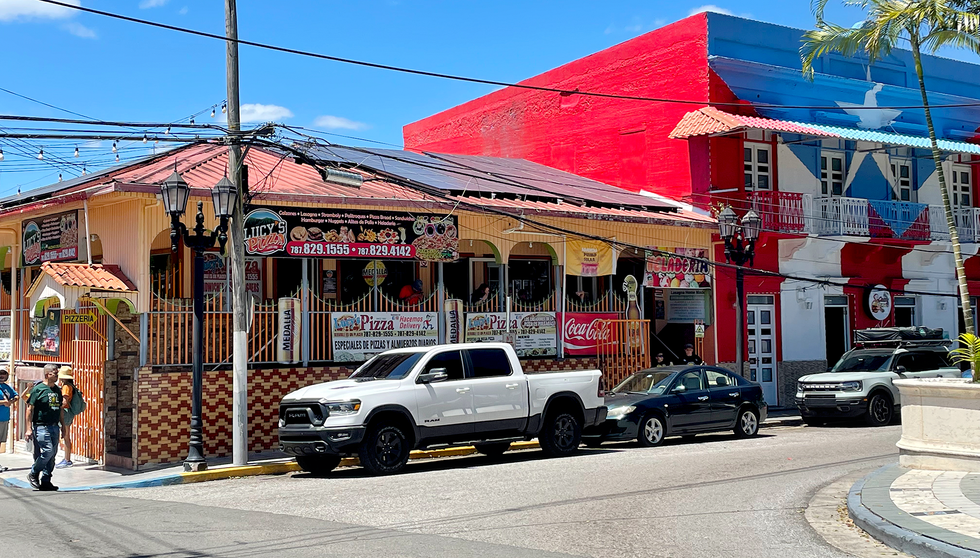 The pizzeria in Adjuntas is connected to a microgrid. Even if the main power grid goes down, the pizzeria should still be able to operate.Heather Duncan/ORNL
The pizzeria in Adjuntas is connected to a microgrid. Even if the main power grid goes down, the pizzeria should still be able to operate.Heather Duncan/ORNL
What is a microgrid orchestrator and how does it work?
Microgrids offer great promise for energy resilience, but they have some limitations. Traditionally, islanded microgrids have rigid boundaries, creating energy silos that can’t communicate with one another or share resources. As a result, power generation and demand may be unevenly distributed across a region: One microgrid where demand is low or generation is high may have excess generation that goes to waste, while another microgrid nearby may have to disconnect electrical loads due to insufficient generation or high demand.
To tackle this challenge, our team at Oak Ridge National Laboratory (ORNL), in Tennessee, with funding from the Department of Energy’s Solar Energy Technologies Office, is designing a microgrid orchestrator that can interconnect islanded microgrids. At present, there’s no single standard for microgrid architecture, and so the orchestrator is designed to be compatible with any type of microgrid controller. The orchestrator works with local microgrid controllers to optimize and coordinate the distribution of the available electricity supply. It does so by creating an artificial electricity market among the microgrids. In this market, the microgrids can sell or buy power from neighboring microgrids based on their local needs.
The orchestrator looks at the power imbalance—the difference between generation and loads—for each microgrid. Its pricing algorithm then adjusts the pricing signal, which is sent out to each microgrid. The pricing signal isn’t the actual amount that a customer will pay for electricity. Rather, it’s a transactive signal used within the network of microgrids to determine if a specific microgrid will buy power from, or sell power to, its neighbors. The pricing signal is periodically updated based on the power imbalance and other factors.
 In a hurricane-prone region like Puerto Rico, it’s good to be prepared. The pharmacy, hardware store, bakery, and barbershop are connected to the Adjuntas microgrids, and in extreme events, they will continue to serve the community.Clockwise from top left: Erika P. Rodriguez/The New York Times/Redux; Maximiliano Ferrari/ORNL; Heather Duncan/ORNL (2)
In a hurricane-prone region like Puerto Rico, it’s good to be prepared. The pharmacy, hardware store, bakery, and barbershop are connected to the Adjuntas microgrids, and in extreme events, they will continue to serve the community.Clockwise from top left: Erika P. Rodriguez/The New York Times/Redux; Maximiliano Ferrari/ORNL; Heather Duncan/ORNL (2)
Usually, the optimization of a microgrid is centralized, with the central controller gathering information from and controlling each device, which could be, among other things, a PV inverter, battery inverter, or controllable load. Based on forecasts of loads and generation, it determines the optimal way to distribute power and sends instructions to each device. For example, it will prioritize a critical load like life-support equipment over a noncritical load like office lighting to ensure that the critical load remains powered. While a centralized approach is simpler to formulate than a distributed one, it requires full access to data and struggles to handle a large number of devices.
The orchestrator’s distributed approach, by contrast, is highly scalable, as the optimization problem is divided into microgrid-size chunks. The orchestrator doesn’t control the individual devices in the microgrid network. Instead, the local microgrid controllers maintain full control of their assets, such as PV panels, and they react to the pricing signal and make their own decisions about buying or selling power to one or more neighboring microgrids. This approach preserves the autonomy and privacy of each microgrid.
Adjuntas will be an ideal location to demonstrate our microgrid orchestrator. Currently, the region has more than 400 solar installations, capable of generating over 600 kW in bright sunlight. The fire station, barber shop, and several grocery stores are all powered by solar energy. The energy landscape is thus a glimpse of the transformation that needs to happen in Puerto Rico if the island is to reach its goal of 100 percent renewable energy by 2050. Microgrids with energy storage will help stabilize the larger grid as it integrates more distributed, intermittent generation coming from solar and wind power.
How do hardware-in-the-loop tests help validate new technology?
Before deploying the microgrid orchestrator in the field, we are conducting a comprehensive validation of the technology in the lab. ORNL has two state-of-the-art facilities dedicated to microgrid research. One uses a hardware-in-the-loop (HIL) platform, which mimics a real system by integrating physical equipment such as external controllers into a simulation. The other is a network microgrid facility based on actual hardware.
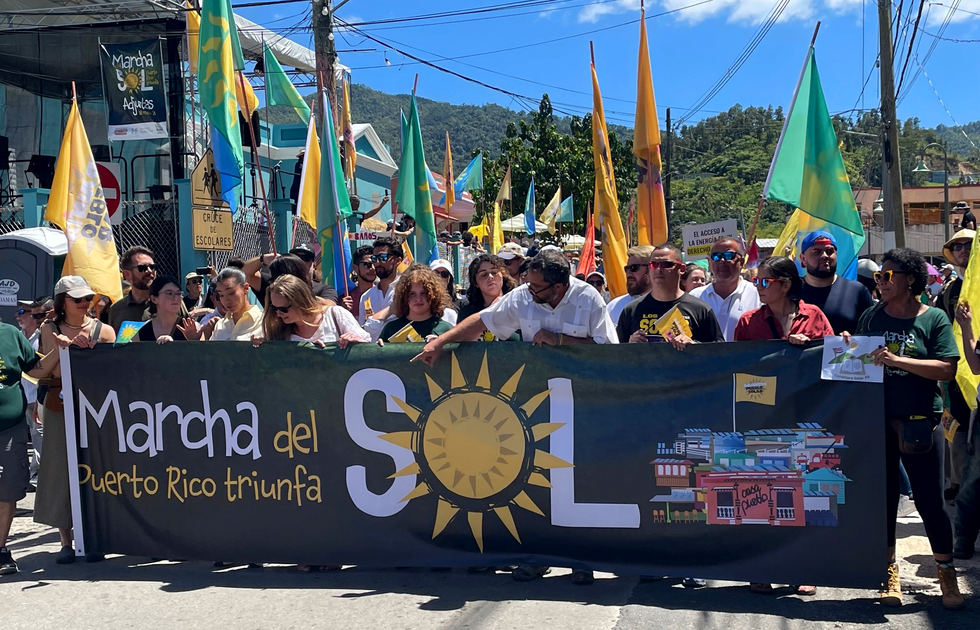 Last March, Adjuntas celebrated its commitment to self-sufficient solar power. The microgrid technology being deployed there could be a model for the rest of Puerto Rico and other parts of the world.Heather Duncan/ORNL
Last March, Adjuntas celebrated its commitment to self-sufficient solar power. The microgrid technology being deployed there could be a model for the rest of Puerto Rico and other parts of the world.Heather Duncan/ORNL
At ORNL, the HIL simulator includes a detailed model of the Adjuntas microgrids, including PV inverters, energy storage, and protective systems, and it uses actual measurements of electricity consumption from each business, as well as PV inverter generation. This detailed simulation is thus validating the operation of the orchestrator in a safe and controllable virtual environment.
The hardware testbed consists of three microgrids, each of which integrates commercial PV inverters, energy-storage inverters, and synchronous machines to emulate conventional backup generation. The microgrids can be configured to operate in grid-connected or islanded mode, or as a network. The hardware testbed uses emulators for PV generation and loads, and we’ll use data collected in Adjuntas through weather stations and data loggers to replicate those conditions in the lab.
In the scenarios we have been evaluating, we’re seeing that during normal conditions, when the main grid is healthy, having a network of microgrids facilitates the exchange of power between the microgrids, reducing the need to shed loads on cloudy days and maximizing the economic benefits. In Adjuntas, that means that surplus power generated in the northeast section of town will help support the power-hungry critical loads in the west, such as at the pharmacy.
During a prolonged power outage following a storm, the testbed shows that a microgrid that’s been damaged can use both PV generation and battery resources from its neighbors. In that extreme scenario, the orchestrator will move electricity between the microgrids and allow every watt produced by the remaining solar panels to be used, minimizing the need to cut electricity to critical loads.
How can a network of microgrids keep the lights on during a power outage?
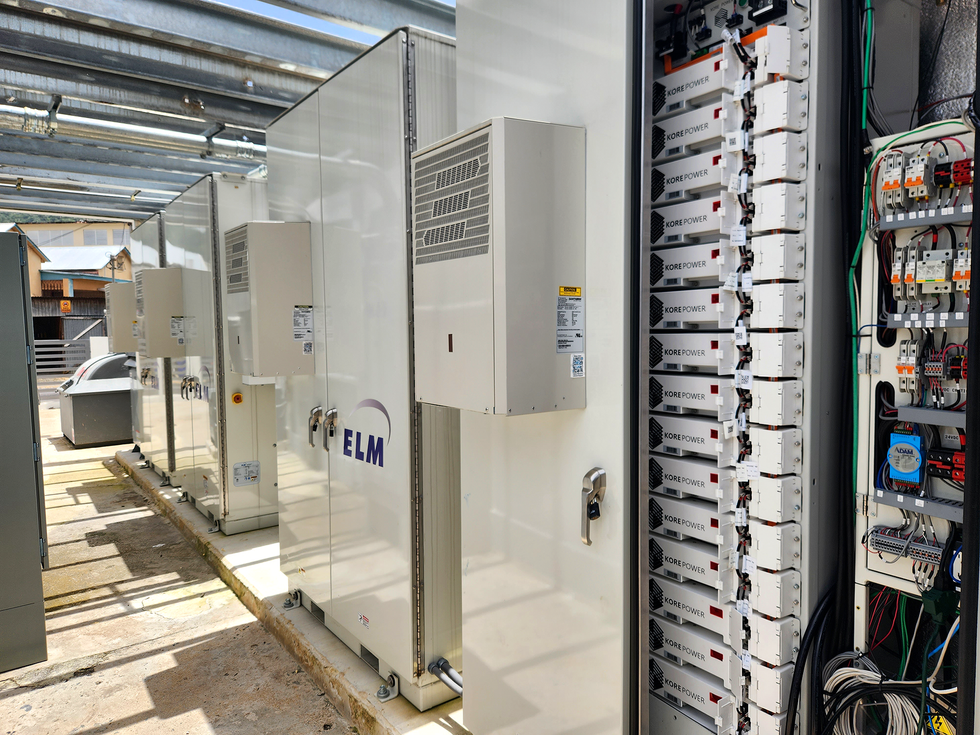
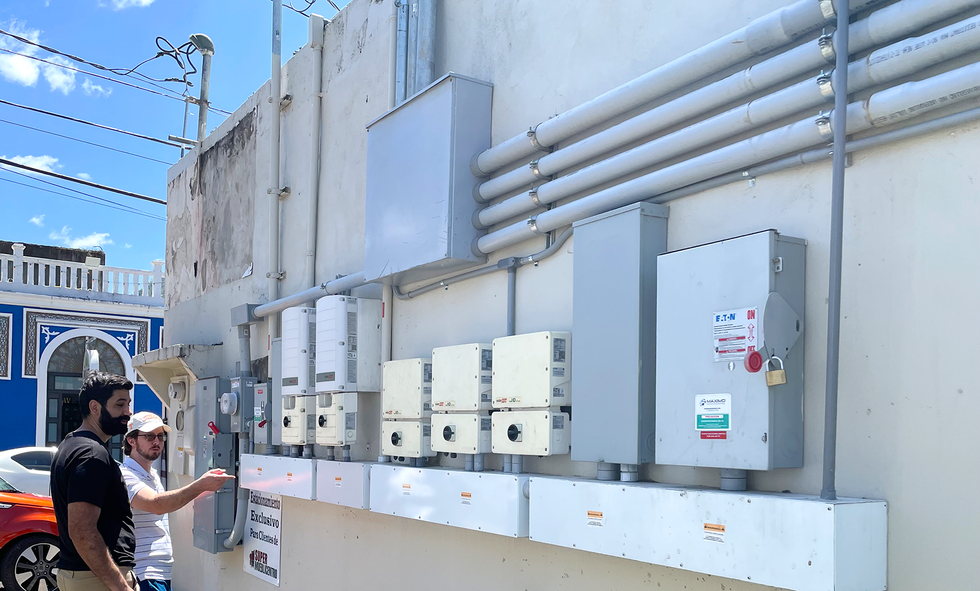
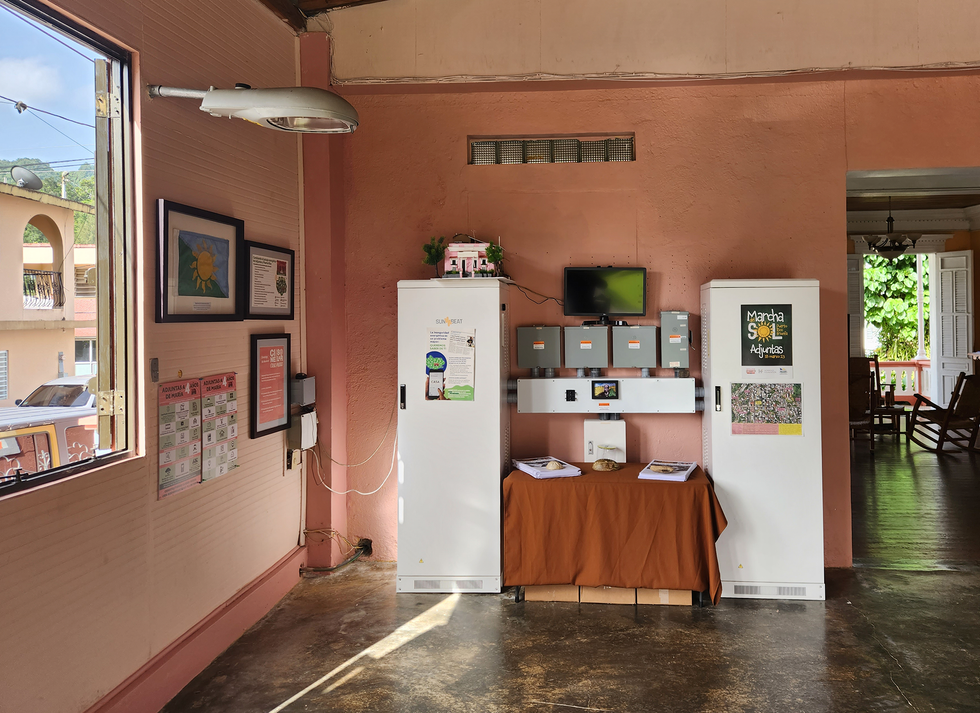 Adjuntas’s two microgrids are designed to operate in islanded mode, disconnected from the main power grid. In a demonstration next year, they will be networked together with a microgrid orchestrator.Top and bottom: Maximiliano Ferrari/ORNL; Middle: Heather Duncan/ORNL
Adjuntas’s two microgrids are designed to operate in islanded mode, disconnected from the main power grid. In a demonstration next year, they will be networked together with a microgrid orchestrator.Top and bottom: Maximiliano Ferrari/ORNL; Middle: Heather Duncan/ORNL
The ORNL microgrid orchestrator is the centerpiece of a group of related technologies. Another component we’re working on with the University of Tennessee, Knoxville, are controls that will allow a microgrid that is operating in islanded mode to extend its reach and pick up additional loads and generation that are outside the microgrid’s boundaries.
Setting up a microgrid with dynamic rather than fixed boundaries is particularly important during long-term outages. In those instances, grid-connected PV installations in the affected part of the network will go off line because their commercial PV inverters require AC voltage to operate. But if a microgrid has dynamic boundaries, its voltage could reach PV installations in the affected area—which could be part of another microgrid or not connected to any microgrid—and bring them back on line.
Although we plan to test this concept in the lab, implementing it in the field will require permission from the main utility. Similar technology has been successfully tested in an airport microgrid in Chattanooga, Tenn. In a community like Adjuntas, which already has hundreds of distributed PV installations, dynamic boundaries would let each microgrid serve more customers while benefiting from their additional generation. And in general, this approach will help facilitate the integration of more renewable energy sources into the main grid.
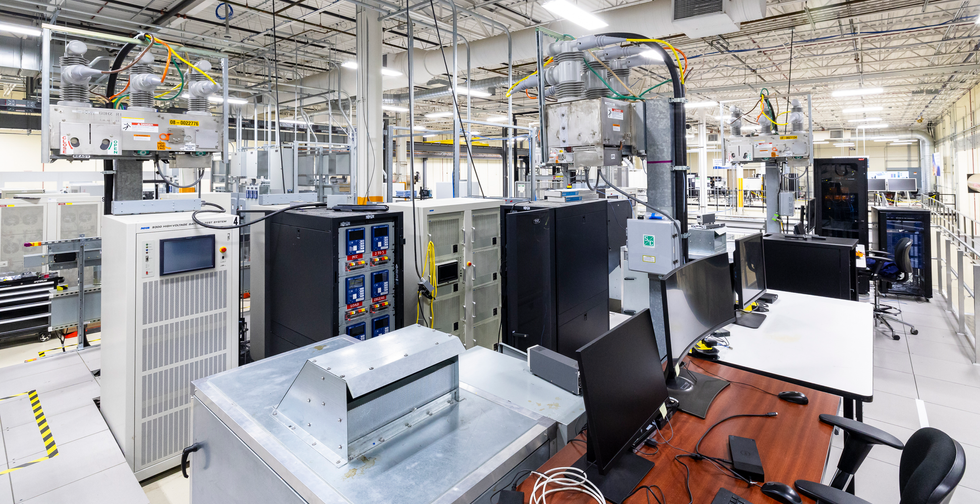 At Oak Ridge National Laboratory, researchers are testing microgrid hardware and running simulations of microgrid operation based on real-world data collected in Adjuntas, Puerto Rico. Carlos Jones/ORNL/U.S. Department of Energy
At Oak Ridge National Laboratory, researchers are testing microgrid hardware and running simulations of microgrid operation based on real-world data collected in Adjuntas, Puerto Rico. Carlos Jones/ORNL/U.S. Department of Energy
Another enabling technology we’re working on is a distributed architecture that lets the microgrid orchestrator communicate securely with the microgrid controllers, which in turn communicate with field devices, such as PV inverters and battery storage. We call this architecture ORNL CODAS, which stands for Control and Optimization using Distributed Agent-based System.
As the name suggests, this distributed platform is based on agents, which are software entities that can make decisions based on their programmed logic. The CODAS agents rely on peer-to-peer communications, the peers in this case being the PV inverters, energy-storage controllers, and other microgrid devices and assets. This arrangement is critical when the orchestrator loses communication with one or more of the microgrid controllers.
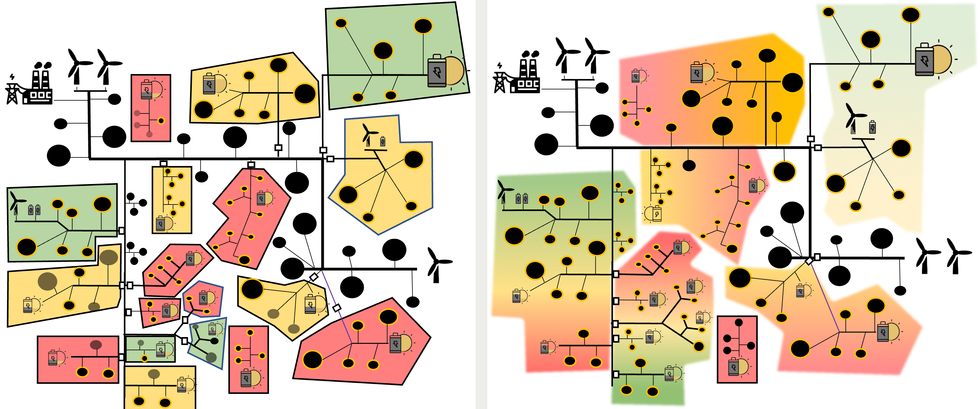 Islanded microgrids [left] can fail if generation and loads become unbalanced. Networking the microgrids together [right] using technology such as ORNL’s microgrid orchestrator allows them to share resources and makes them more resilient. Maximiliano Ferrari/ORNL
Islanded microgrids [left] can fail if generation and loads become unbalanced. Networking the microgrids together [right] using technology such as ORNL’s microgrid orchestrator allows them to share resources and makes them more resilient. Maximiliano Ferrari/ORNL
With a centralized microgrid architecture, the loss of communication between the microgrid controller and the microgrid devices can lead to the collapse of the entire microgrid. In an agent-based architecture like CODAS, the agents will temporarily take control of the microgrid assets to maintain power until the communication link is restored. For example, the energy-storage agent can communicate with the PV agents to prevent the state of charge of the battery from going beyond the maximum or minimum threshold. This agent-based approach brings another layer of resiliency to keep the lights on in extreme events.
Meanwhile, the residents of Adjuntas continue to support the push for energy self-sufficiency. On 18 March 2023, thousands of people came to Casa Pueblo for the inauguration of the two microgrids. The parade through town was not only a celebration—it was a community statement demanding clean and resilient energy for the island of Puerto Rico. The residents want to be among the first all-solar towns in the world, an ambitious goal but one that’s already in progress and within reach. ORNL is developing the controls that will support this vision in Adjuntas and beyond, creating the foundation for a highly integrated power grid based on renewable energy.
ACKNOWLEDGMENTS
The authors thank Cynthia Arellano of the Honnold Foundation; Guodong Liu, Aditya Sundararajan, Mohammed Olama, Ben Dean, Heather Duncan at ORNL; Yang Chen at North Carolina Agricultural and Technical State University; Fabio Andrade and Gerson Beauchamp at the University of Puerto Rico Mayagüez; Aleksandar Dimitrovski at the University of Central Florida; and Fred Wang at the University of Tennessee, Knoxville.
The Department of Energy will provide public access to these results of federally sponsored research, in accordance with the DOE Public Access Plan.
Reference: https://ift.tt/mQ2DKOJ
No comments:
Post a Comment